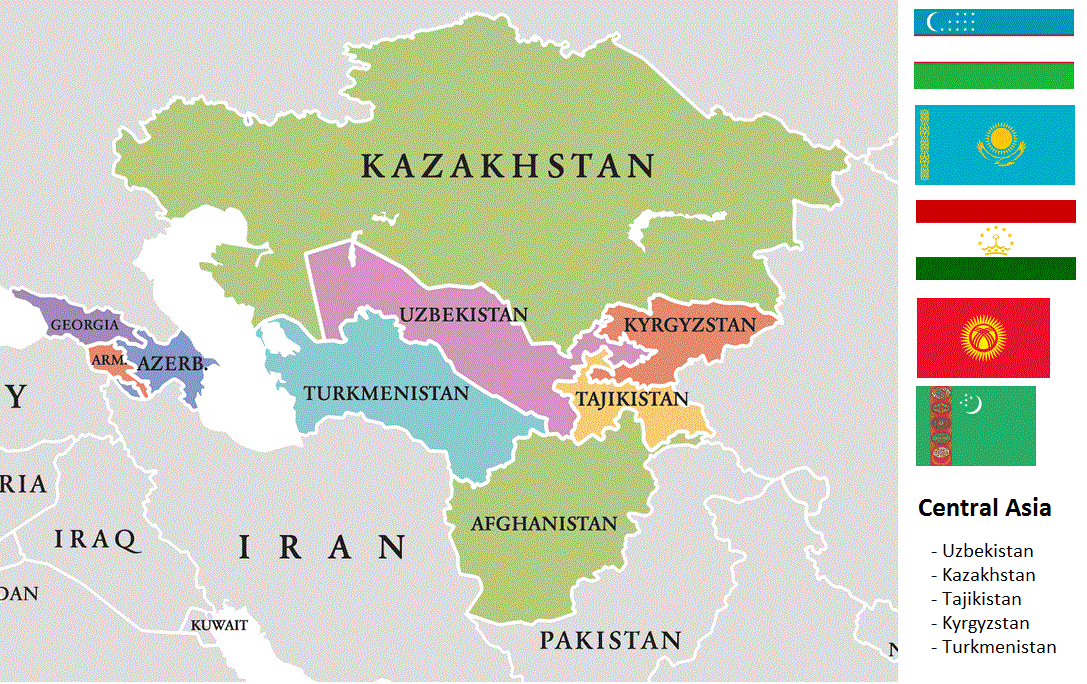Countries in Central Asia
Central Asia, as its name implies, is located in the center of the Asian continent, between the Caspian Sea, China, northern Iran and southern Siberia. The region comprises the area of countries, such as Kazakhstan, Kyrgyzstan, Uzbekistan and others.
How Many Countries in Central Asia
As a region of Asia, Central Asia is composed of 5 independent countries (Kazakhstan, Kyrgyzstan, Tajikistan, Turkmenistan, and Uzbekistan). See below for the full list of Central Asian Countries by population.
1. Kazakhstan
Kazakhstan, formally the Republic of Kazakhstan, is a country in Central Asia with a small part in Eastern Europe. It borders Turkmenistan, Uzbekistan and Kyrgyzstan to the south, China to the east and Russia to the north.
 |
|
2. Kyrgyzstan
Kyrgyzstan, officially the Republic of Kyrgyzstan, is a country in Central Asia. The coastal and hilly country borders Kazakhstan, China, Tajikistan and Uzbekistan. The capital is Bishkek.
 |
|
3. Tajikistan
Tajikistan, formally the Republic of Tajikistan, is a state in Central Asia bordering Afghanistan, China, Kyrgyzstan and Uzbekistan.
 |
|
4. Turkmenistan
Turkmenistan is a republic in southwestern Central Asia. It stretches from the Caspian Sea east to Afghanistan and borders Iran to the south, and Kazakhstan and Uzbekistan to the north.
 |
|
5. Uzbekistan
Uzbekistan, formally the Republic of Uzbekistan, is a coastal state in Central Asia bordering Kazakhstan, Turkmenistan, Kyrgyzstan, Tajikistan and Afghanistan.
 |
|
List of Countries in Central Asia and Their Capitals
As noted above, there are five independent countries in the Middle Asia. Among them, the largest country is Uzbekistan and the smallest is Turkmenistan in term of population. The full list of Central Asia countries with capitals is shown in the table below, ranked by latest total population and area.
| Rank | Country Name | Population | Land Area (km²) | Capital |
| 1 | Uzbekistan | 33,562,133 | 425,400 | Tashkent |
| 2 | Kazakhstan | 18,497,064 | 2,699,700 | Astana |
| 3 | Tajikistan | 8,931,000 | 141,510 | Dushanbe |
| 4 | Kyrgyzstan | 6,389,500 | 191,801 | Bishkek |
| 5 | Turkmenistan | 5,942,089 | 469,930 | Ashgabat |
Map of Middle Asian Countries

Brief History of Central Asia
Early History and Ancient Civilizations
Central Asia, often referred to as the “heartland of Eurasia,” has been a crossroads of civilizations for millennia. Its history is deeply intertwined with the movements of peoples, trade routes, and cultural exchanges.
1. Early Civilizations:
Central Asia witnessed the rise of several ancient civilizations, including the Oxus Civilization (also known as the Bactria-Margiana Archaeological Complex) along the Amu Darya River in present-day Turkmenistan and Uzbekistan. These societies engaged in agriculture, metalworking, and trade, leaving behind impressive archaeological sites like Gonur Tepe and Tillya Tepe.
2. Nomadic Empires:
From around 800 BCE, nomadic tribes such as the Scythians, Sarmatians, and Xiongnu roamed the vast steppes of Central Asia. They were skilled horsemen and archers, often clashing with settled civilizations to the south and east. The Xiongnu, in particular, posed a significant challenge to the Chinese Han Dynasty.
Islamic Conquests and Silk Road Prosperity
1. Islamic Conquests:
In the 7th and 8th centuries CE, Islam spread across Central Asia through Arab conquests. The region became an integral part of the Islamic world, with cities like Samarkand, Bukhara, and Khiva flourishing as centers of trade, scholarship, and Islamic culture. The Samanid Empire, centered in modern-day Uzbekistan and Tajikistan, played a crucial role in the region’s Islamization.
2. The Silk Road:
Central Asia’s position at the crossroads of trade routes connecting East Asia, South Asia, the Middle East, and Europe led to its prosperity during the heyday of the Silk Road. Caravans carrying silk, spices, precious metals, and other goods traversed the region, fostering cultural exchange and economic growth.
Mongol Empire and Timurid Renaissance
1. Mongol Conquests:
In the 13th century, the Mongol Empire, under the leadership of Genghis Khan and his successors, swept across Central Asia, bringing much of the region under their rule. The vast empire facilitated trade and communication between East and West but also brought destruction and upheaval.
2. Timurid Renaissance:
Amid the aftermath of the Mongol conquests, Central Asia experienced a cultural and artistic renaissance under the Timurid Empire, founded by the Turkic-Mongol conqueror Timur (Tamerlane). Cities like Samarkand and Herat became renowned centers of Islamic architecture, literature, and scholarship.
Colonialism, Soviet Rule, and Independence
1. Colonial Influence:
During the 19th century, Central Asia came under the influence of the Russian Empire, which sought to expand its territory and secure access to lucrative trade routes and natural resources. The region was divided into various administrative units, including the Khanates of Khiva, Bukhara, and Kokand.
2. Soviet Rule:
Following the Russian Revolution of 1917, Central Asia was incorporated into the Soviet Union as constituent republics, experiencing rapid industrialization, collectivization of agriculture, and suppression of religious and cultural practices. Urban centers grew, and education and healthcare systems were modernized, but political dissent was ruthlessly suppressed.
3. Independence:
With the collapse of the Soviet Union in 1991, the Central Asian republics—Kazakhstan, Kyrgyzstan, Tajikistan, Turkmenistan, and Uzbekistan—gained independence. They faced the challenges of nation-building, transition to market economies, and asserting their identities on the global stage amidst geopolitical competition between Russia, China, and other regional powers.
Contemporary Challenges and Opportunities
1. Political Stability:
Central Asia continues to grapple with issues of political authoritarianism, corruption, and ethnic tensions, which pose challenges to democratic governance and social stability.
2. Economic Development:
While endowed with abundant natural resources such as oil, gas, and minerals, Central Asia faces the task of diversifying its economies, reducing dependence on extractive industries, and fostering inclusive growth and development.
3. Geopolitical Dynamics:
The region’s strategic location has made it a focal point of competition between major powers, including Russia, China, and the United States, as well as regional actors like Iran and Turkey. Balancing these competing interests while maintaining sovereignty and stability is a key challenge for Central Asian states.













































